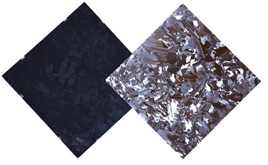|
Welcome to the Brandt group
Group leader: Prof. Dr. Martin Brandt
Black Silicon surfaces
Light is reflected whenever it passes from one material to another. This also happens when light enters a solar cell. The reflection can be minimized by using anti-reflection coatings such as those often found on glasses/spectacles. On crystalline Silicon, this anti-reflection coating usually consists of a thin layer of SiN3. It is optimized to suppress reflection of red light and does not work as well in the blue, which accounts for the slightly bluish color exhibited by most multicrystalline Si solar cells.

We have developed a new method to structure the surface of Si-based solar cells so that it transmits light with minimal reflection losses over the whole useful spectral range. The technique is based on the local catalytic action of nanometer-sized Au dots when the surface coated with them is exposed to a particular etching solution. The result is a nanostructured surface where the refractive index gradually changes from that of air to that of Si. If this happens on a length scale smaller than the wavelength of light, its reflection is suppressed.
The technique works on all different kinds of Si-based solar cells, including single- and multicrystalline cells as well as cells made from hydrogenated amorphous Silicon. In addition to a reduction of the reflection losses, the nanotextured surfaces lead to the trapping of light, which allows the solar cells to be thinner than those with conventional anti-reflection coatings, resulting in a significant cost reduction.
Selected publications
-
Black nonreflecting silicon surfaces for solar cells
Applied Physics Letters 88 203107 (2006)
S. Koynov, M. S. Brandt, M. Stutzmann
-
Black multi-crystalline silicon solar cells
physica status solidi-rapid research letters 1 R53 (2007)
S. Koynov, M. S. Brandt, M. Stutzmann
|
|
|



 We have developed a new method to structure the surface of Si-based solar cells so that it transmits light with minimal reflection losses over the whole useful spectral range. The technique is based on the local catalytic action of nanometer-sized Au dots when the surface coated with them is exposed to a particular etching solution. The result is a nanostructured surface where the refractive index gradually changes from that of air to that of Si. If this happens on a length scale smaller than the wavelength of light, its reflection is suppressed.
We have developed a new method to structure the surface of Si-based solar cells so that it transmits light with minimal reflection losses over the whole useful spectral range. The technique is based on the local catalytic action of nanometer-sized Au dots when the surface coated with them is exposed to a particular etching solution. The result is a nanostructured surface where the refractive index gradually changes from that of air to that of Si. If this happens on a length scale smaller than the wavelength of light, its reflection is suppressed.